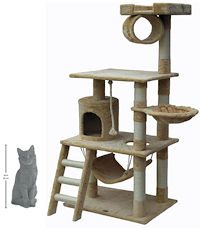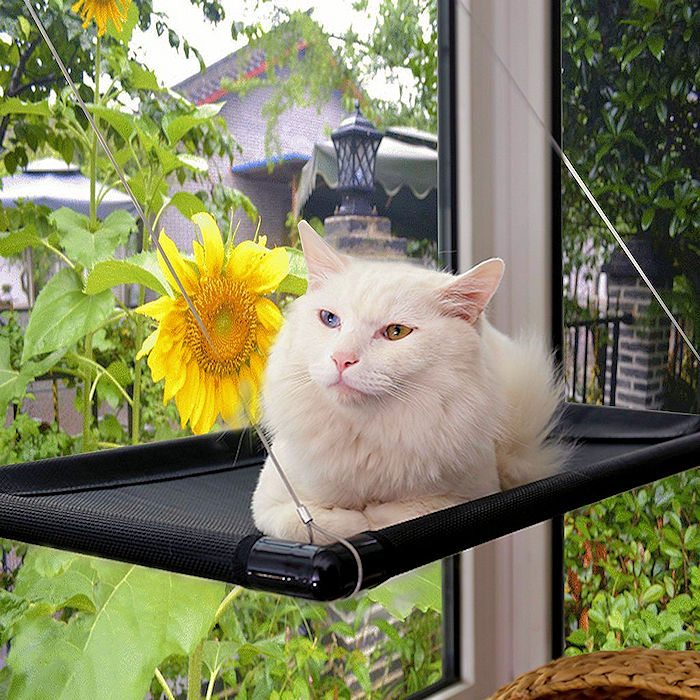|
|
 I hope this advice comes in handy and helps you as it has helped us to trim those sharp little claws. As most of us already know, our feline friends can become very difficult when it comes to nail grooming. I hope this advice comes in handy and helps you as it has helped us to trim those sharp little claws. As most of us already know, our feline friends can become very difficult when it comes to nail grooming.
At times it’s just not worth the time and effort to keep the cat still, try to avoid being scratched plus making sure the cats nails don’t get clipped to short and all at the same time. So instead of wrestling with our pet or taking the cat to a groomer and paying each time our cats claws need to be trimmed, we came up with a nifty, quick and safe way to get the job done, without all the fuss.
What you will need:
– 2 People
– 1 Pair of Cat Clippers
– 1 Cat
– 1 Screen (such as a screen that’s fitted in a door or window)
One person will be holding the cat up to the screen the other person will be on the other side of the screen waiting with the clippers. Hold your kitty up and close to the screen in time your cat will start to cling and hold on to the screen with their nails when they do, the person on the other side of the screen will see their nails poking through the holes of the screen. Be patient at first your cat might me hesitant to grab onto the screen but in time they will (haven’t heard of one that didn’t yet)
It’s important that you do not let go of your cat when they start to cling always keep a gentle hold on their body, the last thing you want is for them to suddenly let go and have them fall to the ground. While their claws are poking through the holes of the screen, the person on the other side of the screen can easily start to clip the nail as it pokes through, in the beginning the cat may pull back quick when it realizes something just happened, but don’t worry they will quickly poke those nails through again, so they can get a better close up view of what is going on outside.
Before you and the cat knows it all of their nails will be neatly trimmed. If you’re good with the clippers this method can be done very quick and accurate, so fast that the cat doesn’t even have time to realize what had just happened. Trust me on this method we have 2 cats and it has worked wonders for us and all of our cat friend owners who we have shared this idea with.
 Did you ever wonder why your cat carries a dead bird onto the back porch and leaves it at the door, or why your indoor cat drops her small fluffy stuffed toy at your feet? With indoor cats, some cat breeds might be signalling that they want to play fetch with you! More often than not, when a indoor or outdoor cat brings back some “prey” and lays it ceremoniously at your feet it is not an offering to the gods but a deep-rooted instinct taking hold of the feline. Did you ever wonder why your cat carries a dead bird onto the back porch and leaves it at the door, or why your indoor cat drops her small fluffy stuffed toy at your feet? With indoor cats, some cat breeds might be signalling that they want to play fetch with you! More often than not, when a indoor or outdoor cat brings back some “prey” and lays it ceremoniously at your feet it is not an offering to the gods but a deep-rooted instinct taking hold of the feline.
Spayed female cats are much more likely to offer you the gift of a dead mouse or bird because in the wild, all cat mothers twill each their kittens how to eat their food by bringing home their dead or injured prey. This also starts the learning to hunt process for the young kittens who are good students watching their mother’s every move as her maternal instincts awakens the kittens own natural tendencies and instincts.
Domestic cats are no different and still carry the genetic history of their ancestors. This is why outdoor cats will often leave a dead or dying bird on the porch and for indoor cats they will often be seen carrying a small stuffed chew toy to their owner or piling up their favorite stuffed toys around your feet or near your bed.
A cat’s behavior when it comes to their prey is something kittens learn from their moms. My cats never go outside nor do they have any desire to venture into that big scary world on the other side of their favorite window. They prefer the safety and comfort of the living room where they can find a warm patch of sunshine to stretch out in for an afternoon nap. The picture window also gives them a great view of a large Oak tree in the front yard where they can sit and stare at birds and squirrels. A cat’s behavior when it comes to prey is interesting to watch. Their eyes dance with glee, whiskers twitch forward almost in a curl as they crouch waiting patiently. Eager tails flick back and forth in anticipation. They make short, quick rattling noises and their teeth will sometimes chatter. They are on high alert for any bird or squirrel who settles onto the branch closest to the window. Chattering teeth is an unusual cat behavior. The cat has become so stimulated and fixed on his prey that he is actually imagining that he has caught his prey and is killing it with his bite.
An unknowing mouse who picks a household with cats to venture into will soon come to regret his error in judgment. I watch my cats, who appear to be sound sleep, follow along with eager eyes as a mouse carefully and quietly tries to creep across the dining room floor, its eyes fixed on a stray piece of cat food left over from supper. A cat’s behavior is to stalk its prey and as any cat owner knows, a cat is a perfect example in exercising the art of patience. The cat will slowly move her body into a crouch and wait, eyes glued on the mouse. Whiskers twitch in anticipation, she wiggles her hind end slightly. Just before the pounce, she sizes up the distance between herself and the mouse by shaking her head so she can better judge her leap. In an instant, the unlucky rodent finds itself in a game of catch and release. Sometimes the mouse escapes, but not usually.
My Cat Leaving Me Presents & It’s Not Even My Birthday!
 The cat’s behavior of chasing a mouse, small animals or birds is an instinctive reaction learned at birth, but the mother cat has to teach kittens they have to kill in order to eat. All cats are born with an instinct to stalk, hunt, chase and finally catch their prey. Kittens just know they are suppose to chase what moves and those who are born outside with a mother cat who has to catch her own food, learn from her how to stalk, chase and then capture and kill small prey like mice or birds for food. Cats are not natural born hunters who automatically know a mouse is food. Hunting for food is a learned behavior taught to kittens by the their mother. Kittens have to learn this cat behavior in order to survive if they are on their own. The mother cat brings home a dead mouse and eats it where the kittens can watch. Mom eventually gets to the point where she brings home the dead mouse and leaves it for the kittens to eat themselves. All female cats share this behavior. They not only bring their catch home to their kittens, but a female will also share her catch with another mother’s litter. This also is why your cat, usually a female, will bring something they’ve caught home and drop it at your front door. It’s the cat’s inborn behavior to help teach us how to hunt. The cat’s behavior of chasing a mouse, small animals or birds is an instinctive reaction learned at birth, but the mother cat has to teach kittens they have to kill in order to eat. All cats are born with an instinct to stalk, hunt, chase and finally catch their prey. Kittens just know they are suppose to chase what moves and those who are born outside with a mother cat who has to catch her own food, learn from her how to stalk, chase and then capture and kill small prey like mice or birds for food. Cats are not natural born hunters who automatically know a mouse is food. Hunting for food is a learned behavior taught to kittens by the their mother. Kittens have to learn this cat behavior in order to survive if they are on their own. The mother cat brings home a dead mouse and eats it where the kittens can watch. Mom eventually gets to the point where she brings home the dead mouse and leaves it for the kittens to eat themselves. All female cats share this behavior. They not only bring their catch home to their kittens, but a female will also share her catch with another mother’s litter. This also is why your cat, usually a female, will bring something they’ve caught home and drop it at your front door. It’s the cat’s inborn behavior to help teach us how to hunt.
Once the kittens are older, the mother cat will begin bringing home live prey that has been wounded and can’t move as fast so the kittens can hone their hunting skills by making their own kill. It sounds cruel, but it is nature’s way. Most cats who live on the streets don’t have a plate of tasty cat food waiting for them so they have to use all the instincts a cat is born with and use this incredible behavior to survive on their own.
Why does a cat play with its prey? One theory is that the cat doesn’t have enough confidence in itself and they show this behavior because they are afraid of this tiny animal that is trying to bite them and fight back. The other theory is that house cats who don’t have an opportunity to catch a bird, mouse or other small animals are so happy to have caught something they want to enjoy the fun as long as possible. To us, it looks like they are playing, to them it’s perfectly natural cat behavior.
This is also why your indoor cat attacks your finger or toes if they get the chance. Cats are born to chase things. It’s as simple as that. Something moves, the cat’s instinctive behavior is to attack. After all, a cat is a natural born predator. However, this doesn’t mean your cat can fend for themselves outside if they’ve never been taught how or even why they need to catch and kill a mouse or bird. Unless they were taught as a kitten what to do with that mouse in front of them, most inside cats would starve if their owners stopped feeding them from a can or bag. The knowledge of how to catch a mouse is inbred in all cats, but why eat a dead mouse is a complete mystery to most pet cats.
So the next time your cat drops a dead mouse at your feet remember, it’s because they are trying to teach you how to catch food. Just say thank you before you remove it from the house or back door. It’s your cat’s way of showing you how important you are to her. She’s just trying to do her part to make sure you are well cared for.
 Casper is a healthy male who was rescued with his sister Lily by the SPCA. His health and personality blossomed after adoption. Bringing a new cat home is such an exciting time. You will get to know your new cat’s likes, dislikes and personality quite quickly. But how will you be able to tell when your new cat has settled in?
Physical Contact
Many new cat owner’s cannot wait until their new cat feels comfortable enough in their company to be able to tolerate being picked up, held and cuddled. New cats are well known to be skittish and to run from their new cat owners if they approach them rather than run straight to them. This can be quite discouraging to cat owners and it can make them feel as if something is wrong with them. But it is a natural process that all cat owners will have to go through in the beginning. The new cat will need some time to settle in and to build up its trust in you. The cat may warm to you sooner than you expect. But if it takes time, do not rush the cat by continually picking it up and making a fuss of it.
Cats will only tolerate affection on their own terms. Anything other than that is seen as a nuisance. Over time, the cat will tolerate more and more affection. Some cats become lap cats and look for every opportunity they can to jump into their owner’s laps or lie beside them as they sleep, while others will eventually allow their owners to pick them up and hold them without struggling to be put back down.
 Pleased to See You Pleased to See You
Cats are not as aloof as many people assume they are. Cats can and do show their pleasure at seeing their owners as they return home from work or first thing in the morning as they wake up and sit down to have some breakfast. Some cats greet their owners with an affectionate rub around their legs or a meow accompanied by close physical contact. Another way to tell if your new cat has settled in is to observe how your cat behaves when you leave the room. Does your cat follow you wherever you go? This shows that your cat likes your company and wants to be around you. It is easy to read the signs that cats give off.
If you are considering obtaining a new cat, do not expect the cat to warm to you right away. Give your cat time to settle in and get used to its new surroundings. You will find that over time, the cat will show more affection for you and want to be around you. This is when you can tell for sure that the new cat has settled in.
 When you bring your cat home, one of the first things you may want to do is schedule an appointment with your vet to have him or her look over your new feline. You will need to find a veterinarian with whom you feel you can have a long-term relationship. After all, your vet will be the one providing your precious cat with medical care. You need to be as discerning with a veterinarian as you are with your own doctor, so you need to ask the right questions and know what to look for in your vet. When you bring your cat home, one of the first things you may want to do is schedule an appointment with your vet to have him or her look over your new feline. You will need to find a veterinarian with whom you feel you can have a long-term relationship. After all, your vet will be the one providing your precious cat with medical care. You need to be as discerning with a veterinarian as you are with your own doctor, so you need to ask the right questions and know what to look for in your vet.
What to Look For in a Vet
First, you will want to find a vet that is fairly close to home. Even if your breeder or friend insists that they have found the best vet in the world, you want your veterinarian to be close to where you live in case of an emergency.
Still, most towns have more than one veterinarian, so you should have several doctors to choose from when selecting a vet. In some areas there are vets that will even come out to your home.
Next you need to see which vets do a lot of work with small animals, or even see if there is a vet nearby that specializes in cats. There are a number of benefits to finding a vet that specializes in cats. For instance, you never have to share a waiting room with other animals that can tempt or intimidate your cat. You will also be working with a vet that has specialized knowledge about how to treat feline issues.
You also need to check into the hours of operation. Are the hours convenient for your schedule? What arrangements do they have for after-hours emergency care? The size of the clinic is another thing to think about. There is no right or wrong in the size of a clinic, but you have to decide what is important to you.
 Do you want to go with a smaller clinic where you may be able to see the same vet every time, or do you want a larger, state of the art veterinary clinic? Of course, if you are lucky you may even be able to find a small, state of the art clinic. You also need to decide if you want a veterinary office that is connected to an animal hospital on-site where your cat will have access to surgical procedures. Do you want to go with a smaller clinic where you may be able to see the same vet every time, or do you want a larger, state of the art veterinary clinic? Of course, if you are lucky you may even be able to find a small, state of the art clinic. You also need to decide if you want a veterinary office that is connected to an animal hospital on-site where your cat will have access to surgical procedures.
If you are interested in holistic procedures or specialized services like dental care, you need to take that into consideration when choosing a veterinarian. Cost is another important consideration. Although cost should not be the only thing you consider, prices vary among service providers. Do not be blinded by price though, there are many well-qualified vets that offer services for less than less experienced veterinarians. Finding the right vet still comes down to asking even more questions.
When you have narrowed down your search, you need to begin asking the right questions. You are going to vet the vet. Visit the clinic before you make an appointment and take a good look around. Are things clean? Does the clinic seem to be operating smoothly? Is the equipment clean and updated?
Take a look at the staff. You will be working with the receptionist and the veterinary assistants as often as the vet, so you need to see how they interact with the animals as well as the people. Are they professional? Enthusiastic?
You also need to ask some question about the veterinarian. Find out if he or she has pets. It may seem silly to ask that type of question, but most pet lovers want their vet to be a pet lover, too.
Does the vet have any specializations or have they done any studies on feline physiology or behavior? This tends to show an interest in cats. Also, make sure your vet can explain things clearly to you and make sure you can get along. You need to respect your vet’s decisions and not feel like you have to fight to get your cat what it needs. Also, watch how the vet handles cats, and when you come for your first visit make sure he or she handles your cat with care.
 The Margay is an exotic cat known for their slimness and grace. They have also been named the long-tailed spotted cat which derives from their appearance. The Margay closely resembles the Ocelot, and is much smaller than the average exotic cat. They are found generally in Central and South America, and have been known to live a lifespan of about 20 years. While they are small, they are actually recognized as one of the best and agile climbers out there. This exotic cat can actually be a pet; however, for those who are interested in this, it is important to do your research, and find out more about how to care and train this species of exotic cat properly. The Margay is an exotic cat known for their slimness and grace. They have also been named the long-tailed spotted cat which derives from their appearance. The Margay closely resembles the Ocelot, and is much smaller than the average exotic cat. They are found generally in Central and South America, and have been known to live a lifespan of about 20 years. While they are small, they are actually recognized as one of the best and agile climbers out there. This exotic cat can actually be a pet; however, for those who are interested in this, it is important to do your research, and find out more about how to care and train this species of exotic cat properly.
A mature Margay can be from 24 to 27 inches long, and weigh up to eighteen pounds, and as less as nine or ten pounds. They have a long-tail as their other name implies which is a reason why they are such good climbers. The background coat color is generally a tawny yellow or a light brown color with solid dark brown or black spots on their coat. There are differences in the coats and the spot size variations depending on the region that they live in.
The Margay is generally nocturnal in nature, and their diet consists of tree frogs, birds, insects, and small monkeys. They generally will hunt in the trees because they are such avid climbers; in fact, they have become so good in this skill that they are capable of climbing head-down down the trees. In fact, from their bones and structure, it is pretty obvious that they have developed specialized claws, and ankles joints for faster and easier climbing. Because their diet is not something you can feed them in captivity, some people just feed their Margay’s commercial cat food; however, you should take recommendations from your exotic pet veterinarian, and follow them for the benefit of the Margay. Most will generally recommend a source of fresh meat.
The Margay is recommended to have their own enclosure which needs to be built according to states rules and regulations. They need to have an area where they can climb, and where they can be above the ground as it is usually more comfortable to them. Dens and hiding places should be built so that the Margay feels more at home; the environment should generally be as close to their natural environment as possible.
It is also important to learn how to train, and to train the Margay – especially to discipline their behavior. If you let bad behavior go when they are young, the problem will escalate once they have matured; in short, do not tolerate bad behavior when they are young, and discipline them to be obedient and understand what their limits are.
According to a website known as Indian Tiger, the Margay was considered to be threatened because deforestation and illegal hunting have affected their population number. For one, because the forest is the Margay’s home when deforestation occurs, the home of the Margay is at stake. Also, while illegal hunting for their fur does not happen anymore, their pelts can still be occasionally found in the market; keep in mind that hunting them for their pelts is illegal.
|
|
 I hope this advice comes in handy and helps you as it has helped us to trim those sharp little claws. As most of us already know, our feline friends can become very difficult when it comes to nail grooming.
I hope this advice comes in handy and helps you as it has helped us to trim those sharp little claws. As most of us already know, our feline friends can become very difficult when it comes to nail grooming.







 Did you ever wonder why your cat carries a dead bird onto the back porch and leaves it at the door, or why your indoor cat drops her small fluffy stuffed toy at your feet? With indoor cats, some cat breeds might be signalling that they want to play fetch with you! More often than not, when a indoor or outdoor cat brings back some “prey” and lays it ceremoniously at your feet it is not an offering to the gods but a deep-rooted instinct taking hold of the feline.
Did you ever wonder why your cat carries a dead bird onto the back porch and leaves it at the door, or why your indoor cat drops her small fluffy stuffed toy at your feet? With indoor cats, some cat breeds might be signalling that they want to play fetch with you! More often than not, when a indoor or outdoor cat brings back some “prey” and lays it ceremoniously at your feet it is not an offering to the gods but a deep-rooted instinct taking hold of the feline. The cat’s behavior of chasing a mouse, small animals or birds is an instinctive reaction learned at birth, but the mother cat has to teach kittens they have to kill in order to eat. All cats are born with an instinct to stalk, hunt, chase and finally catch their prey. Kittens just know they are suppose to chase what moves and those who are born outside with a mother cat who has to catch her own food, learn from her how to stalk, chase and then capture and kill small prey like mice or birds for food. Cats are not natural born hunters who automatically know a mouse is food. Hunting for food is a learned behavior taught to kittens by the their mother. Kittens have to learn this cat behavior in order to survive if they are on their own. The mother cat brings home a dead mouse and eats it where the kittens can watch. Mom eventually gets to the point where she brings home the dead mouse and leaves it for the kittens to eat themselves. All female cats share this behavior. They not only bring their catch home to their kittens, but a female will also share her catch with another mother’s litter. This also is why your cat, usually a female, will bring something they’ve caught home and drop it at your front door. It’s the cat’s inborn behavior to help teach us how to hunt.
The cat’s behavior of chasing a mouse, small animals or birds is an instinctive reaction learned at birth, but the mother cat has to teach kittens they have to kill in order to eat. All cats are born with an instinct to stalk, hunt, chase and finally catch their prey. Kittens just know they are suppose to chase what moves and those who are born outside with a mother cat who has to catch her own food, learn from her how to stalk, chase and then capture and kill small prey like mice or birds for food. Cats are not natural born hunters who automatically know a mouse is food. Hunting for food is a learned behavior taught to kittens by the their mother. Kittens have to learn this cat behavior in order to survive if they are on their own. The mother cat brings home a dead mouse and eats it where the kittens can watch. Mom eventually gets to the point where she brings home the dead mouse and leaves it for the kittens to eat themselves. All female cats share this behavior. They not only bring their catch home to their kittens, but a female will also share her catch with another mother’s litter. This also is why your cat, usually a female, will bring something they’ve caught home and drop it at your front door. It’s the cat’s inborn behavior to help teach us how to hunt.
 Pleased to See You
Pleased to See You When you bring your cat home, one of the first things you may want to do is schedule an appointment with your vet to have him or her look over your new feline. You will need to find a veterinarian with whom you feel you can have a long-term relationship. After all, your vet will be the one providing your precious cat with medical care. You need to be as discerning with a veterinarian as you are with your own doctor, so you need to ask the right questions and know what to look for in your vet.
When you bring your cat home, one of the first things you may want to do is schedule an appointment with your vet to have him or her look over your new feline. You will need to find a veterinarian with whom you feel you can have a long-term relationship. After all, your vet will be the one providing your precious cat with medical care. You need to be as discerning with a veterinarian as you are with your own doctor, so you need to ask the right questions and know what to look for in your vet. Do you want to go with a smaller clinic where you may be able to see the same vet every time, or do you want a larger, state of the art veterinary clinic? Of course, if you are lucky you may even be able to find a small, state of the art clinic. You also need to decide if you want a veterinary office that is connected to an animal hospital on-site where your cat will have access to surgical procedures.
Do you want to go with a smaller clinic where you may be able to see the same vet every time, or do you want a larger, state of the art veterinary clinic? Of course, if you are lucky you may even be able to find a small, state of the art clinic. You also need to decide if you want a veterinary office that is connected to an animal hospital on-site where your cat will have access to surgical procedures. The Margay is an exotic cat known for their slimness and grace. They have also been named the long-tailed spotted cat which derives from their appearance. The Margay closely resembles the Ocelot, and is much smaller than the average exotic cat. They are found generally in Central and South America, and have been known to live a lifespan of about 20 years. While they are small, they are actually recognized as one of the best and agile climbers out there. This exotic cat can actually be a pet; however, for those who are interested in this, it is important to do your research, and find out more about how to care and train this species of exotic cat properly.
The Margay is an exotic cat known for their slimness and grace. They have also been named the long-tailed spotted cat which derives from their appearance. The Margay closely resembles the Ocelot, and is much smaller than the average exotic cat. They are found generally in Central and South America, and have been known to live a lifespan of about 20 years. While they are small, they are actually recognized as one of the best and agile climbers out there. This exotic cat can actually be a pet; however, for those who are interested in this, it is important to do your research, and find out more about how to care and train this species of exotic cat properly.